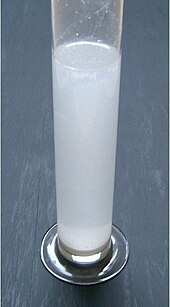Tin (II) hydroxide
| Structural formula | |||||||||||||
|---|---|---|---|---|---|---|---|---|---|---|---|---|---|
|
|
|||||||||||||
| General | |||||||||||||
| Surname | Tin (II) hydroxide | ||||||||||||
| other names |
Tin dihydroxide |
||||||||||||
| Molecular formula | Sn (OH) 2 | ||||||||||||
| Brief description |
white, amorphous powder |
||||||||||||
| External identifiers / databases | |||||||||||||
|
|||||||||||||
| properties | |||||||||||||
| Molar mass | 152.716 g mol −1 | ||||||||||||
| Physical state |
firmly |
||||||||||||
| safety instructions | |||||||||||||
|
|||||||||||||
| As far as possible and customary, SI units are used. Unless otherwise noted, the data given apply to standard conditions . | |||||||||||||
Tin (II) hydroxide is a chemical compound from the group of hydroxides with tin in oxidation level II.
Extraction and presentation
When dilute alkali hydroxide is added to tin (II) salt solutions, a white precipitate is formed which is sparingly soluble in water. The equation for the formation of the pure hydroxide is as follows:
Similar to lead (II) hydroxide , however, Sn (OH) 2 are hydrated oxides with the composition SnO · x H 2 O (x <1). The term tin (II) hydroxide is usually used synonymously.
The composition of the oxide hydrates is controversial in the literature. For example, the following formulas are given
- 2SnO · H 2 O
- 3SnO · H 2 O
- 3SnO • 2H 2 O
- 5SnO • 2H 2 O
The only one of these compounds with a known crystal structure is 6SnO · 2H 2 O (3SnO · H 2 O) = Sn 6 O 4 (OH) 4 . The substance consists of individual clusters in the form of a rhombic dodecahedron , in which the tin (II) ions are arranged in an octahedral manner and the triangular surfaces of the octahedron are covered by oxide and hydroxide ions.
It has been reported that the reaction of the organotin compound Me 3 SnOH with tin (II) chloride pure Sn (OH) 2 can be obtained. However, the structure of the product is not known.
properties
If tin (II) hydroxide is heated in an oxygen-free atmosphere, a blue-black powder, tin (II) oxide, is formed through dehydration .
Like all tin (II) compounds, the hydroxide is also a reducing agent and easily oxidizes to tin (IV) oxide .
Tin (II) hydroxide is amphoteric , it reacts both with strong acids and with strong bases. With strong acids it forms tin (II) salts and with strong alkalis it forms stannates (II) , outdated called stannites. The latter are thus salts of a tin (II) acid, which forms both tri- [Sn (OH) 3 ] - and tetra-hydroxotin (II) - [Sn (OH) 4 ] 2− compounds. The oxide hydrate dissolves in strong bases to form the alkali stannates (II). The reaction equation for the reaction with sodium hydroxide to form sodium stannate (II) is as follows:
literature
- AF Holleman , E. Wiberg : Textbook of Inorganic Chemistry . 37-39 Edition. Walter de Gruyter, Berlin 1956, pp. 353-354.
- Jander-Wendt , 3rd edition, S. Hirzel Verlag, Stuttgart 1959.
Individual evidence
- ^ A b David R. Lide, Mary Lide: CRC Handbook of Chemistry and Physics . 87th edition, CRC Press, 1998, ISBN 9780849305948 , pp. 4/95
- ↑ There is not yet a harmonized classification for this substance . A labeling of Tin dihydroxide in the Classification and Labeling Inventory of the European Chemicals Agency (ECHA), which was accessed on July 29, 2019, is reproduced from a self-classification by the distributor .
- ↑ a b c A. F. Holleman , E. Wiberg : Textbook of Inorganic Chemistry . 37-39 Edition. Walter de Gruyter, Berlin 1956, p. 354.
- ↑ a b W. D. Honnick, JJ Zuckerman: Tin (II) hydroxide , Inorg. Chem. , 1976, 15 (12), 3034-3037, doi : 10.1021 / ic50166a019
- ^ RA Howie, W. Moser: Structure of Tin (II) “Hydroxide” and Lead (II) “Hydroxide” . In: Nature . tape 219 , no. 5152 , July 1968, p. 372-373 , doi : 10.1038 / 219372a0 .
- ^ I. Abrahams, SM Grimes, SR Johnston, JC Knowles: Tin (II) Oxyhydroxide by X-ray Powder Diffraction . In: Acta Crystallographica Section C Crystal Structure Communications . tape 52 , no. 2 , February 15, 1996, p. 286-288 , doi : 10.1107 / s0108270195012625 .



